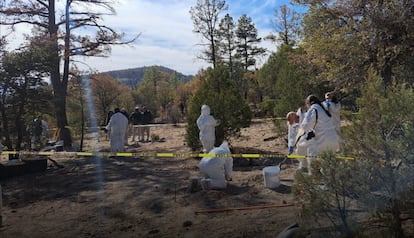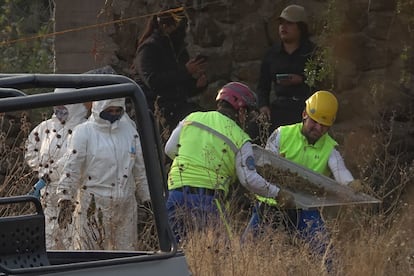Mexico keeps finding clandestine graves, but the government no longer shares the statistics
The discovery of dozens of illegal burials in Chihuahua, San Luis Potosí and elsewhere this year by activists and local authorities is not being reflected in official figures, underscoring the administration’s lack of transparency since mid-2023

Immersed in a crisis of violence that seems to have no end, Mexico is adding up dozens of deaths and disappearances every day, as well as shootouts, exploding mines, drones that drop bombs... And then there are the mass graves, clandestine burials that have numbered in the thousands in recent years. These are part of the criminal methods used by the mafias, which try to hide the bodies of their enemies after the latter go missing. In these years of violence, which will soon reach two decades, the statistics on mass graves and missing persons have helped to get a sense of the extent of Mexico’s safety problem. But now, spotty publication of these figures — or the outright abandonment of the effort — has returned the country to darkness.
The situation is critical, not just now with Claudia Sheinbaum in the presidency, but also under previous governments, whether run by Morena, the Institutional Revolutionary Party (PRI) or the National Action Party (PAN). The discovery of clandestine graves is continuous. In the first weeks of this year alone, local prosecutors and groups of relatives of missing persons announced the discovery of around 40 in Casas Grandes, Chihuahua; another 16 in Río Verde, San Luis Potosí, and at least one in Xochimilco, in the south of Mexico City. The corpses are always located thanks to the efforts of these groups, often the only driving force behind the searches. As for the criminals, they are rarely brought to justice.
The prosecutors’ offices are supposed to add the findings of graves and human remains to their various databases: the National Forensic Data Bank, the National Registry of Deceased, Unidentified and Unclaimed Persons; the National Registry of Common Graves and Clandestine Graves, and the National Genetic Information Base. These databases are also supposed to coordinate with the National Registry of Missing Persons, which was the subject of a major controversy during the government of Andrés Manuel López Obrador (2018-2024), due to the executive’s attempts to alter the figures, alleging that the stratospheric numbers did not match reality.

The Attorney General’s Office (FGR) should have an updated map of graves, similar to the one published by the Ministry of the Interior a year and a half ago, with data from the federal investigative agency and local prosecutors. But it is not known whether such an update is in its power or not. Since the Ministry of the Interior published the map of graves in mid-2023, neither the agency nor the FGR have updated their figures. Mexico officially does not know how many clandestine graves have been found on its territory from May 1, 2023 until today. In a request for information to the FGR last year, the collective Where the disappeared go requested the details of the records included in the registry of graves and the response was just a number, 1,789, which did as much to explain the situation as a humidity percentage explains the vast immensity of the sea.
The safety problem is a challenge and a bother for the government. The arrival of Morena to power in 2018 heralded an era of transparency. The country at that point lacked reliable databases of missing persons and clandestine graves. The government of Enrique Peña Nieto (2012-2018) had been negligent, as had that of Felipe Calderón before him (2006-2012). Over the years, the López Obrador executive built and published databases, but time and electoral goals eventually distorted the effort. The government stopped updating its map of graves, while the FGR looked the other way. The registry of missing persons was involved in the downward review controversy, a situation that generated a number of problems, including missing persons who were suddenly no longer in the registry.
The problem with the registration of missing persons has now been somewhat addressed. The country has around 115,000 missing persons, according to the National Search Commission, which answers to the Interior Ministry. But there is no information on the graves. According to the map published by the agency in 2023, between December 1, 2018 (when the López Obrador administration took power) to April 30, 2023 (when the statistics stopped being updated), Mexico registered 2,863 graves, more than 300 in Colima and Veracruz, more than 200 in Sinaloa, Guerrero and Michoacán…
It is difficult to compare the beginning of López Obrador’s term with that of Sheinbaum’s due to the lack of data. During the former’s first three months in office, prosecutors reported the discovery of 191 graves. These days there is no official data. The government says that it is the task of the Prosecutor’s Office, and the Prosecutor’s Office, when asked about it, does not answer. Only the newspaper archive records remain.
In addition to the graves in San Luis Potosí, Chihuahua, and Mexico City, since October 1, when Sheinbaum’s term began, activists and local authorities have found graves in Tabasco, Sonora (at least 26, near Hermosillo), Jalisco, State of Mexico, and Chiapas (around 30 since December alone.) Another issue is the bodies. The map of graves published by the government in 2023 only mentioned the number of graves, but said nothing about the remains found inside. Another pending issue of the Sheinbaum administration and of the FGR itself, now overseen by Alejandro Gertz, is to update and publish the public versions of the National Forensic Data Bank.
Sign up for our weekly newsletter to get more English-language news coverage from EL PAÍS USA Edition
Tu suscripción se está usando en otro dispositivo
¿Quieres añadir otro usuario a tu suscripción?
Si continúas leyendo en este dispositivo, no se podrá leer en el otro.
FlechaTu suscripción se está usando en otro dispositivo y solo puedes acceder a EL PAÍS desde un dispositivo a la vez.
Si quieres compartir tu cuenta, cambia tu suscripción a la modalidad Premium, así podrás añadir otro usuario. Cada uno accederá con su propia cuenta de email, lo que os permitirá personalizar vuestra experiencia en EL PAÍS.
¿Tienes una suscripción de empresa? Accede aquí para contratar más cuentas.
En el caso de no saber quién está usando tu cuenta, te recomendamos cambiar tu contraseña aquí.
Si decides continuar compartiendo tu cuenta, este mensaje se mostrará en tu dispositivo y en el de la otra persona que está usando tu cuenta de forma indefinida, afectando a tu experiencia de lectura. Puedes consultar aquí los términos y condiciones de la suscripción digital.
More information
Archived In
Últimas noticias
The metaverse, four years later: Is it finished or just at a standstill?
$3,000 and a plane ticket: The United States increases incentives for migrants to self-deport before the end of the year
Charles Dubouloz, mountaineering star, retires at 36 with a farewell tour inspired by Walter Bonatti
From the White House to diplomatic gifts: Lego wins over adult fans, brick by brick
Most viewed
- The low-cost creative revolution: How technology is making art accessible to everyone
- Christian Louboutin: ‘Young people don’t want to be like their parents. And if their parents wear sneakers, they’re going to look for something else’
- All the effects of gentrification in one corner of Mexico’s Colonia Roma
- Christmas loses its festive spirit: ICE fears cast shadow over religious celebrations
- Liset Menéndez de la Prida, neuroscientist: ‘It’s not normal to constantly seek pleasure; it’s important to be bored, to be calm’











































